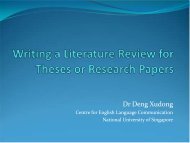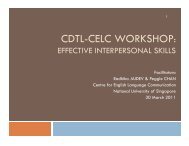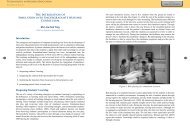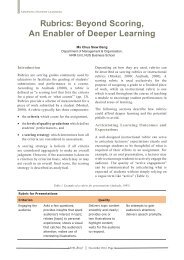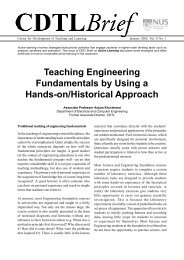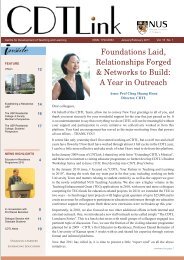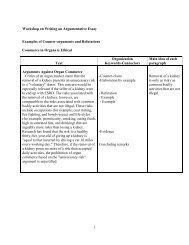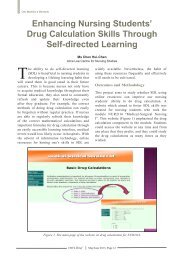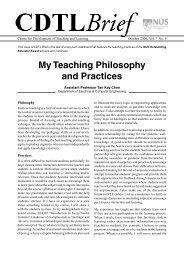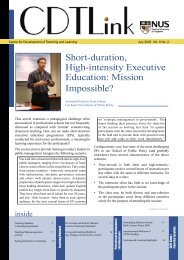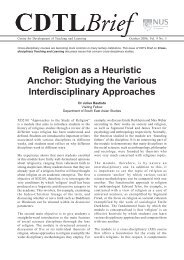The Art of Not Learning: Two Versions - CDTL - National University ...
The Art of Not Learning: Two Versions - CDTL - National University ...
The Art of Not Learning: Two Versions - CDTL - National University ...
Create successful ePaper yourself
Turn your PDF publications into a flip-book with our unique Google optimized e-Paper software.
Centre for Development <strong>of</strong> Teaching and <strong>Learning</strong> January 2008, Vol. 11 No. 1<br />
This issue <strong>of</strong> <strong>CDTL</strong> Brief discusses various issues and aspects <strong>of</strong> Independent <strong>Learning</strong>, incorporating views<br />
from NUS faculty and a student.<br />
<strong>The</strong> <strong>Art</strong> <strong>of</strong> <strong>Not</strong> <strong>Learning</strong>:<br />
<strong>Two</strong> <strong>Versions</strong><br />
Dr Gwee Li Sui<br />
Department <strong>of</strong> English Language & Literature<br />
Possibly everyone in the business <strong>of</strong> teaching<br />
becomes familiar at some point with the saying<br />
“Give a man a fish and you feed him for a day, but<br />
teach him to fish and you feed him for life”. Yet, in<br />
any protracted discussion on education, the axiom<br />
is bound to be raised again as if it were an end in<br />
itself, the final word on all that has fallen rather<br />
fashionably under the term independent learning.<br />
Its folk attribution to Laozi notwithstanding, a<br />
statement so frequently repeated in glee has the<br />
effect <strong>of</strong> encouraging one to feel less and less<br />
impressed. In my case, it has already put me <strong>of</strong>f<br />
fishing as a hobby altogether.<br />
Let me clarify at length my sense <strong>of</strong> discomfort<br />
here. To be sure, I do grant that fishing can<br />
have very pr<strong>of</strong>ound recreational values; if this<br />
is debatable, I fall back on its status at least<br />
among the oldest pr<strong>of</strong>essions to have given the<br />
human species a chance at mastering its own<br />
survival and future. In fact, for every fish I<br />
consume, I find myself compulsively grateful to<br />
the fish, the fisherman, and the fisherman who<br />
taught that fisherman. A proverb’s life is quite<br />
a different matter: it begins with a glimpse <strong>of</strong><br />
truth via its wit, what combines—<strong>of</strong>ten in equal<br />
measures—novelty and extremely good sense.<br />
Once understood though, its words feel old almost<br />
too soon, at which stage very little can be gained<br />
from regurgitation alone. <strong>The</strong> pleasure it now<br />
<strong>of</strong>fers lies elsewhere, in the way one is able to<br />
rediscover its underlying truth through careful<br />
and regular self-correction.<br />
If mere citation then guarantees not a speaker’s<br />
but mostly a hearer’s engagement, you can see<br />
why showy public repetition is a rather worrying<br />
development. Indeed, when the speaking context<br />
itself appears increasingly to confuse “giving a<br />
fish” and “teaching how to fish”, this worry surges<br />
even further. I have always thought that “getting<br />
a fish” means not just being spoon-fed but also<br />
getting to the end speedily, with minimal struggle,<br />
while “learning to fish” acknowledges hard work<br />
and the risk <strong>of</strong> not even getting fish on some days.<br />
Yet, in this strange age, the saying has been bent<br />
<strong>of</strong>ten in support <strong>of</strong> flashy self-congratulatory<br />
slogans that invert the relation, such as ‘teach less,<br />
learn more’. From my own experiences, whenever<br />
I teach less, my listeners learn even lesser, but<br />
I have been assured that inspiring—not usefully<br />
differentiated from entertaining—does amount to<br />
teaching less. That puzzles me as surely helping<br />
someone to fish, as opposed to just giving fish,<br />
concerns teaching something and so teaching<br />
more.<br />
An advocate <strong>of</strong> this ‘new pedagogy’ may correct<br />
me here by explaining that the dictate ‘teach less’<br />
really means ‘teach smart’—another lamentable<br />
catchphrase. One is supposedly a smart teacher<br />
who plans lessons in a way that lets students<br />
regularly enjoy what they are encountering. <strong>The</strong><br />
key assumption seems to be that fun is a reliable<br />
gateway to learning independently, that someone<br />
excited on milk will go on to eat meat better<br />
Indeptlearningi.indd 1 25/01/2008 14:31:41
than another who cuts his or her gums on meat.<br />
It implies, in other words, that a long and rough<br />
process <strong>of</strong> learning is <strong>of</strong>ten so soul-destroying<br />
that it can at best produce a healthy independent<br />
thinker by chance. Keeping students happy may<br />
be very rewarding for some, but my only point here<br />
is that the fisherman proverb does not say this at<br />
all. Everyone knows just how good one lazy hour<br />
feels, and so it baffles me that a lesson in fishing<br />
should be deemed naturally more enjoyable than<br />
a plate <strong>of</strong> free fish. Indeed, if one bothers to ask<br />
any Laozi critic, one will also realise that the<br />
application would not amuse Laozi much either.<br />
<strong>The</strong> maxim is, quite simply, not about teaching<br />
less or smart but about teaching what is essential.<br />
Essence here is determined not by what is <strong>of</strong><br />
interest to know but by what needs to be learnt,<br />
not by how fun fishing can be or how funny a<br />
fisherman is but by the mere fact that fishing<br />
is taught. No claim is made for the centrality<br />
<strong>of</strong> entertaining, simplifying or beautifying<br />
knowledge, or creating convenient closures,<br />
or, to be sure, the inverse right <strong>of</strong> a teacher to<br />
be indifferent, rude or sadistic. Nor is a link<br />
asserted between a student’s willingness to learn<br />
and an instructor’s competence and integrity: did<br />
not Laozi himself—if we are still engaging his<br />
wisdom—believe that real knowledge could be<br />
learnt but never taught <strong>The</strong> fact that all these<br />
irrelevant meanings are added says a lot about our<br />
own modern classrooms where educators seem<br />
too consumed by the ranging opinions <strong>of</strong> their<br />
charges. As such, even if a teacher knows better,<br />
he or she feels compelled to choose this path <strong>of</strong><br />
quick validation, where one can be loved more<br />
readily, openly and directly, over that on which<br />
any appreciation for teaching what matters may at<br />
best trickle in late, from thoughtful hindsight.<br />
That the former option has grown to a point<br />
where it can socially devalue the latter is indeed<br />
regrettable, although its current sway is not<br />
absolute. Especially when a proverb’s radical<br />
sense is so compromised that one cannot hear<br />
it again without mishearing, something original<br />
always remains to be rediscovered by just<br />
thinking contrarily. <strong>The</strong> last time I encountered<br />
the saying in a discussion on lesson planning<br />
with gimmicks, I found myself imagining a man<br />
who was precisely given a fish and slept very<br />
happy that night. When nothing came his way the<br />
following few days, his own hunger and curiosity<br />
led him to start experimenting and exploring<br />
independently. At first, he worked on methods<br />
<strong>of</strong> finding fish, and the process taught him skills<br />
relating to intuiting, devising and fine-tuning.<br />
When fish and fishing could no longer please<br />
him, he turned this knowledge to looking for<br />
new sources <strong>of</strong> food via methods such as hunting,<br />
planting, cultivating, domesticating and so on.<br />
My daydreaming broke <strong>of</strong>f here, but its revelation<br />
should be obvious: there can also be a form <strong>of</strong><br />
spoon-feeding in means that equate learning<br />
with angling for easy consumption. However, if<br />
challenge is a central concern, then even the gift<br />
<strong>of</strong> a fish can be effective; conversely, teach a man<br />
to fish, and he may still be eating fish at the end<br />
<strong>of</strong> his life.<br />
<strong>CDTL</strong> Brief / January 2008, Page 2<br />
Indeptlearningi.indd 2 25/01/2008 14:31:41
<strong>The</strong> Bookends <strong>of</strong> USP <strong>Learning</strong>:<br />
From WCT to ISM<br />
Dr Johan Geertsema, Dr Andrew Leng, Dr Lo Mun Hou & Dr Barbara Ryan<br />
<strong>University</strong> Scholars Programme<br />
Most students’ tenure in the <strong>University</strong> Scholars<br />
Programme (USP) is ‘bookended’ by two learning<br />
experiences. In their first year, USP students<br />
enroll in Writing and Critical Thinking (WCT)<br />
modules, which introduce them to the genre <strong>of</strong><br />
the academic essay. <strong>The</strong>se modules treat writing<br />
and thinking as inextricable activities, enabling<br />
students to engage critically with texts and issues.<br />
USP students subsequently (usually in their third<br />
and fourth years) embark on advanced curricula,<br />
<strong>of</strong> which a key part comprises Independent Study<br />
Modules (ISMs). In these one-on-one classes,<br />
each student works closely with a faculty member<br />
on a topic devised by the student.<br />
Seen this way, WCT modules and ISMs mark the<br />
start and end respectively <strong>of</strong> a student’s time in the<br />
USP. WCT modules and ISMs are very different<br />
kinds <strong>of</strong> classes in many ways; one introduces or<br />
initiates; the other is a kind <strong>of</strong> culmination. WCT<br />
classes are small, but not quite the individualised<br />
experiences ISMs are. Moreover, while writing<br />
classes are highly interactive, they are nevertheless<br />
guided by the writing pr<strong>of</strong>essors (i.e. all four <strong>of</strong><br />
us). ISMs, as the name suggests, expect students<br />
to be independent and very self-motivated.<br />
Indeed, unlike the intense and regular nature <strong>of</strong><br />
WCT modules, students taking ISMs only meet<br />
their faculty members a handful <strong>of</strong> times during a<br />
semester, leaving students to do most <strong>of</strong> the work<br />
on their own.<br />
Despite these differences, WCT modules and ISMs<br />
share much ground in terms <strong>of</strong> skills, goals and<br />
developmental templates, and we want to sketch,<br />
in this article, some <strong>of</strong> the continuities between<br />
these two kinds <strong>of</strong> USP classes. To begin with,<br />
the most obvious way in which these two types <strong>of</strong><br />
classes are on a continuum is that WCT modules<br />
introduce students to the protocols <strong>of</strong> academic<br />
writing and research. <strong>The</strong> specific skills taught in<br />
writing classes prove indispensable when students<br />
write the longer papers that are the culmination <strong>of</strong><br />
their ISMs or their honours theses. Most writing<br />
modules, for example, include sections devoted to<br />
helping students develop research skills, ranging<br />
from the slightly mundane (e.g. using library<br />
databases), to the technical (e.g. citations).<br />
But useful skills introduced in WCT modules go<br />
beyond the technical. For example, students in<br />
WCT classes explore the key idea <strong>of</strong> “motive”,<br />
which Gordon Harvey defines as “the reason,<br />
which [a writer needs to] establish at the start…<br />
why a reader…might want to read an essay on<br />
this topic.” A motive is therefore the puzzle,<br />
problem or question that the essay grapples with.<br />
This concept translates easily to larger research<br />
projects like ISMs; indeed, “motive” is what<br />
students must confront most immediately as they<br />
draw up ISM study plans.<br />
Many students feel challenged by this<br />
responsibility; they wonder, “how can I know<br />
what I am doing before I do it” But just as Harvey<br />
distinguishes motive (the question) from thesis<br />
(the answer) in an academic essay, an ISM project<br />
can likewise be thought <strong>of</strong> that way. To see why,<br />
it helps to realise that a student may not know<br />
the answers at the start <strong>of</strong> an ISM. That student<br />
does need, however, to have a sense—through<br />
some preliminary research if necessary—<strong>of</strong> what<br />
his or her questions are and why those questions<br />
are intriguing. Put differently, students in ISMs<br />
cannot know in advance what their findings will<br />
be, but they need to know why the investigation is<br />
worth undertaking.<br />
Since “motive” is a useful concept in both WCT<br />
modules and ISMs, it follows that WCT instr uction<br />
on how to generate motives proves useful when<br />
students are conceptualising their ISMs. Question<br />
development constitutes the beginning <strong>of</strong> serious<br />
academic writing. Yet more is required <strong>of</strong> students<br />
to also learn that writing forms part <strong>of</strong> the process<br />
<strong>of</strong> generating ideas that produce a research<br />
question. In WCT modules, prewriting exercises<br />
to help students generate ideas include activities<br />
such as ‘free writing’, annotating and peer review.<br />
<strong>The</strong> process <strong>of</strong> crafting a research question thus<br />
involves interacting with a text (or texts) and with<br />
fellow-students (i.e. other minds). A growing<br />
<strong>CDTL</strong> Brief / January 2008, Page 3<br />
Indeptlearningi.indd 3 25/01/2008 14:31:41
familiarity with this process leads students to a<br />
vital discovery—originality involves and requires<br />
exchange. <strong>The</strong> realisation that critical learning<br />
is dialectical paves the way for ISMs <strong>of</strong> high<br />
calibre.<br />
In this sense, WCT modules do not simply<br />
introduce isolated (technical or even conceptual)<br />
skills that happen to come in useful later in ISMs.<br />
Rather, WCT modules introduce the very idea <strong>of</strong><br />
critical thinking as an underlying principle for all<br />
academic activity. In WCT modules, instructors<br />
help students find, probe and ponder readings<br />
assembled by a working scholar to guide young<br />
learners through new conceptual terrain. Later in<br />
ISMs, students are expected to demonstrate the<br />
ability to not only make original discoveries from<br />
high-level scholarship, but also to locate pertinent<br />
research and justify its use. This aspect <strong>of</strong> an ISM<br />
could be the most daunting. But WCT modules<br />
lay the groundwork for it by emphasising the<br />
interrelatedness <strong>of</strong> independent learning, thinking<br />
and writing.<br />
On its own, a realisation <strong>of</strong> that magnitude might<br />
be hard to grasp or implement. But here again,<br />
WCT training transfers seamlessly into many ISMs<br />
ins<strong>of</strong>ar as the former foregrounds incremental<br />
writing/thinking strategies. In WCT modules,<br />
each student crafts three progressively more<br />
challenging papers whose pedagogical function is<br />
formative and cumulative. To ensure that writing<br />
techniques learnt in previous assignments form<br />
the basis <strong>of</strong> techniques used in subsequent papers,<br />
WCT modules require:<br />
1. ‘Close’ Reading (focused analysis <strong>of</strong> a key<br />
extract/passage)<br />
2. Comparison (comparative ‘close’ reading)<br />
3. Independent Research Paper that includes ‘close’<br />
reading and comparison<br />
Because ISM students must simultaneously<br />
explore and narrow a field <strong>of</strong> research, it can<br />
be beneficial to agree on ‘close’ reading tasks<br />
early in the semester. <strong>The</strong>se focused—hence<br />
manageable—tasks require first-hand engagement<br />
with a primary text. But they also facilitate<br />
inquiry about other primary texts and secondary<br />
sources. Once ‘close’ reading skills are in place,<br />
comparative tasks facilitate controlled widening<br />
<strong>of</strong> an ISM’s focus. In Semester 2, Academic<br />
Year 2005/2006, this strategy helped an English<br />
major hone her broad interest in ‘nostalgia in C.S.<br />
Lewis’ to the more practicable task <strong>of</strong> comparing<br />
representations <strong>of</strong> nostalgia in passages from his<br />
science fiction and his more popular children’s<br />
fantasy, by using comparative ‘close’ readings <strong>of</strong><br />
passages from these works as a basis for making<br />
larger comparisons. <strong>The</strong> result was an argument<br />
chosen for presentation at the USP Academic Fest<br />
in 2006.<br />
<strong>Not</strong> every ISM will be presented in that collegial<br />
setting. Yet every ISM can be a collegial<br />
experience ins<strong>of</strong>ar as USP students learn, in WCT<br />
modules, how deeply intellectual work is enriched<br />
by peer review, networking <strong>of</strong> information<br />
and friendly support. Collegiality may seem<br />
extraneous to independent study. But studies have<br />
shown that this is certainly not true at the Ph.D.<br />
stage. Sternberg (1986) demonstrated that ABDs<br />
(All But the Dissertation)—Ph.D. candidates who<br />
have finished all their requirements save their<br />
dissertations—are less likely to drop out if they<br />
feel a sense <strong>of</strong> social affinity with classmates.<br />
Graff (2000) developed Sternberg’s research by<br />
arguing that doctoral candidates are socialised<br />
to succeed—or fail—on their own because “the<br />
message they get is that if you are any good,<br />
you will already know” (p. 1192). This attitude<br />
is purposefully countered by the academic<br />
exchange and dialogue fostered by WCT modules.<br />
<strong>The</strong>se networks make it easier for ambitious<br />
undergraduates who might not realise the value<br />
<strong>of</strong> collegiality to seek guidance from peers<br />
confidently.<br />
Collegiality exists in several identifiable forms<br />
in WCT modules; indeed, they are built into<br />
most WCT modules. For example, the feedback<br />
students get from their classmates on IVLE<br />
forums and in draft workshops is crucial to WCT<br />
coursework, and one-to-one draft conferences<br />
with instructors and tutorials at the USP Writing<br />
Centre are valuable means for students to<br />
engage in academic exchange. But students are<br />
stretched further if classmates brainstorm, before<br />
conferences are scheduled, about how best to<br />
make use <strong>of</strong> instructors’ limited time. Even the<br />
‘lore’ (and gossip!) that more advanced students<br />
may transmit to students about to embark on<br />
ISMs can be valuable, if in different ways. As<br />
suggested above, the collegiality and camaraderie<br />
that foster a sense <strong>of</strong> others’ ability to contribute<br />
may not at first seem like a pedagogical objective.<br />
But by learning in a small-class setting what one<br />
knows and what one does not know, and how best<br />
to seek support, WCT modules add a vital skill to<br />
young learners’ independent study repertoires.<br />
<strong>CDTL</strong> Brief / January 2008, Page 4<br />
Indeptlearningi.indd 4 25/01/2008 14:31:42
We have argued that there is a mutually reinforcing<br />
pedagogical relationship between the critical<br />
reading, writing and thinking processes and skills<br />
introduced systematically and incrementally in<br />
the USP’s first-year WCT modules, and those<br />
necessary to ensure the successful completion<br />
<strong>of</strong> an advanced ISM. Thus learning that the<br />
formulation <strong>of</strong> a genuine ‘motive’ is the<br />
indispensable starting point for a viable WCT<br />
assignment prepares students to devise a larger—<br />
and perhaps more open-ended—research question<br />
for an ISM with greater confidence. Equally to<br />
the point, we contend that by <strong>of</strong>fering a rich<br />
combination <strong>of</strong> formal frameworks and informal,<br />
peer-support networks, USP modules ‘book-end’<br />
students’ individualised skill-development and<br />
learning achievements.<br />
References<br />
Gordon, H. (1991). “Elements <strong>of</strong> the Essay”. http://www.usp.nus.edu.<br />
sg/writing/resources/elements_<strong>of</strong> _essay.html (Last accessed:<br />
6 November 2007).<br />
Graff, G. (2000). ‘<strong>Two</strong> Cheers for Pr<strong>of</strong>essionalizing Graduate<br />
Students’. PMLA, Vol. 115, No. 5, pp. 1192–1193.<br />
Sternberg, D. (1986). How to Complete and Survive a Doctoral<br />
Dissertation. New York: St Martin’s Press.<br />
Using Wiki to Write Lectures <strong>Not</strong>es<br />
Independently and Collaboratively<br />
Dr Stéphane Bressan<br />
Department <strong>of</strong> Computer Science<br />
Introduction<br />
<strong>The</strong> benefits <strong>of</strong> a student centred teaching<br />
approach and how it motivates individuals to learn<br />
independently, experientially and collaboratively<br />
have been well-documented. It is therefore<br />
pertinent to explore how educational technologies<br />
and tools can help educators and education<br />
technologists implement and deploy applications<br />
supporting constructivist strategies. In this article,<br />
I shall discuss the use <strong>of</strong> Wiki 1 for authoring<br />
lecture notes collaboratively.<br />
Lecture <strong>Not</strong>es<br />
<strong>The</strong> inseparable duo, lectures and lecture notes,<br />
is a part <strong>of</strong> the heritage <strong>of</strong> the German research<br />
university model adopted by American universities<br />
during the 19th century (Russel, 1991) and<br />
progressively by most universities worldwide.<br />
Although students <strong>of</strong>ten perceive note-taking as<br />
a boring, painful and redundant task, it is the<br />
first opportunity for them to engage in independent<br />
learning through critical analysis and synthesis <strong>of</strong><br />
the lecture material and an important exercise in<br />
learning to write in the discipline’s language.<br />
1. Wiki is server s<strong>of</strong>tware that allows users to freely create and<br />
edit web page content using any web browser. Wiki is also<br />
the s<strong>of</strong>tware powering Wikipedia.<br />
<strong>The</strong> Case<br />
CS2102S “Database Systems (S-option)” is an<br />
optional extension to the core module, CS2102<br />
“Database Systems”. CS2102S lets students apply<br />
their newly acquired knowledge and competencies<br />
to the study <strong>of</strong> ancillary database topics (for<br />
instance and in this case non-relational data<br />
models such as XML). <strong>The</strong> module’s teaching<br />
and learning modes are based on independent and<br />
peer learning as well as peer assessment. For two<br />
semesters in Academic Year 2006/2007, computer<br />
science undergraduates taking CS2102S used<br />
Wiki to create their own lecture notes.<br />
Due to the module’s radical teaching strategy, the<br />
Wiki is used with few constraints and restrictions.<br />
Only students taking the module have access to<br />
the Wiki. <strong>The</strong>y can freely create, update or delete<br />
the content. However, they can only modify but<br />
not delete the seven main pages constituting the<br />
front page and the six topic pages (the six main<br />
components <strong>of</strong> the syllabus). <strong>The</strong> web page’s<br />
content is frozen for a few days before the<br />
module’s final test and it is the only authorised<br />
document that students can bring with them for the<br />
test.<br />
<strong>CDTL</strong> Brief / January 2008, Page 5<br />
Indeptlearningi.indd 5 25/01/2008 14:31:43
In their direct or anonymous feedback, students<br />
recognise the learning benefits <strong>of</strong> the approach,<br />
but balance their feedback with criticisms <strong>of</strong> the<br />
rationale (“the…test will only allow students to<br />
[bring] in [the Wiki notes], thereby pressuring<br />
[students] to do a good job”), highlighting some<br />
<strong>of</strong> the difficulties such as the amount <strong>of</strong> effort<br />
and commitment required (“unfortunately we…<br />
don’t have enough time to study this way, [though<br />
forum discussion] and Wiki [are good ways to<br />
learn about the subject]”), and challenges inherent<br />
to independent and peer learning (“the Wiki<br />
notes have lots <strong>of</strong> errors and misunderstandings”,<br />
“[it] is [difficult for] us to verify [whether the<br />
information] is correct”).<br />
Designing Collaborative <strong>Not</strong>es Writing and<br />
Authoring Activities with Wiki<br />
<strong>The</strong> difficulties and challenges <strong>of</strong> independent and<br />
collaborative learning enhance students’ learning<br />
experience. Yet, there are two main issues that<br />
need careful management when designing and<br />
facilitating independent and collaborative notetaking<br />
activities—hive effect and plagiarism.<br />
<strong>The</strong> hive effect is the collective creation <strong>of</strong> junk<br />
when the initial sense <strong>of</strong> ownership arising<br />
from individual participation in the collective<br />
task fizzles out with the loss <strong>of</strong> a sense <strong>of</strong><br />
responsibility. An enthusiasm for creative work, a<br />
sense <strong>of</strong> ownership and the fact that the Wiki notes<br />
are the only authorised documents in the final<br />
test, motivate students to contribute. Colleagues<br />
to whom I have shown the CS2102S Wiki notes<br />
are impressed by their technical quality. Students<br />
are however, more critical <strong>of</strong> the collective effort<br />
and its results. As with any collective task, there<br />
are free riders and passive participants. <strong>The</strong>ir<br />
existence makes those who contribute actively<br />
to the Wiki notes feel indignant. After using a<br />
Wiki for their course, Raitman, Augar & Zhou<br />
(2005) report that their students fear the loss <strong>of</strong><br />
their work because <strong>of</strong> malicious or accidental<br />
deletion by other students or because <strong>of</strong> the lack<br />
<strong>of</strong> concurrency control despite the fact that it<br />
never happened.<br />
Lecture notes in undergraduate courses, unlike<br />
research papers and thesis, are secondary writings<br />
that do not contain a significant amount <strong>of</strong> original<br />
work. It is difficult, in this context to differentiate<br />
plagiarism from note-taking. This is particularly<br />
the case until students are comfortable with<br />
analysis and synthesis. Since learning the<br />
discipline’s language is initially achieved by<br />
imitation, it is necessary to emphasise and to<br />
strictly and continuously enforce the citing <strong>of</strong><br />
sources.<br />
Hive effect, and plagiarism can be managed<br />
through control and assessment tuned to the<br />
needs, requirements and objectives <strong>of</strong> the module.<br />
In CS2102S, control and direct assessment are<br />
kept to their minimum. I have found it useful<br />
to give and impose both a plan (i.e. seven main<br />
pages with sections and subsections <strong>of</strong> the Wiki<br />
together with titles and topics to be developed)<br />
and a compulsory and single case for all examples<br />
in order to improve coherency.<br />
Conclusion<br />
With control, restrictions, fine-tuning and proper<br />
assessment, collaborative authoring s<strong>of</strong>tware such<br />
as Wiki is an indispensable tool in a modern<br />
educator’s toolkit. Since the s<strong>of</strong>tware is usercentred,<br />
its technologies and applications help<br />
students learn independently and collaboratively.<br />
<strong>The</strong> technology can be adopted without rejecting<br />
conventional teaching practices and their benefits.<br />
If managed well, such tools can leverage existing<br />
teaching practices to create an effective blended<br />
learning approach that helps students achieve<br />
better learning outcomes.<br />
Acknowledgement<br />
I would like to thank Elizabeth Ruilin Koh for<br />
an interesting discussion on Wiki and collaborative<br />
learning strategies and for the relevant references<br />
that she gave me. I would like to thank Ann Kian<br />
Yeo, Dennis Puk and Wee Yeh Tan from CITA for<br />
installing and managing MediaWiki (http://www.<br />
mediawiki.org) for this application.<br />
References<br />
Raitman, R., Augar, N. & Zhou, W. (2005). ‘Employing Wikis for<br />
Online Collaboration in the E-learning Environment: Case<br />
Study’. Proceedings <strong>of</strong> the Third International Conference on<br />
Information Technology and Applications (ICITA ’05), Volume<br />
2, pp.142–146.<br />
Russel, D. (1991). Writing in the Academic Disciplines 1870–1990,<br />
A Curricular History. Southern Illinois <strong>University</strong> Press.<br />
<strong>CDTL</strong> Brief / January 2008, Page 6<br />
Indeptlearningi.indd 6 25/01/2008 14:31:43
A Self-directed <strong>Learning</strong> Experience<br />
Dr Tang Bor Luen & Dr Yeong Foong May<br />
Department <strong>of</strong> Biochemistry<br />
Undergraduates should not be spoon-fed, and<br />
indeed some students resent teachers who simply<br />
load them with facts no matter how well the<br />
information is synthesised and organised. Many<br />
students, in fact, prefer to explore and discover<br />
things by themselves. From our own experience,<br />
the satisfaction <strong>of</strong> acquiring knowledge in a selfdirected<br />
manner driven by curiosity is one <strong>of</strong> the<br />
most important factors that brought us to pursue a<br />
career in scientific research.<br />
At NUS, independent study modules (ISM) require<br />
students to do a fair bit <strong>of</strong> self-directed learning<br />
(SDL). Designing a full, (four modular credit) ISM<br />
de novo and getting it accepted by the curriculum<br />
review committee is a great challenge. It may be<br />
very difficult for a single person to cover a novel<br />
topic not already in the curriculum in sufficient<br />
breadth and depth that would be worthy <strong>of</strong> an ISM.<br />
However, incorporating an SDL component in an<br />
existing module that comprises largely didactic<br />
lectures is common practice. This article provides<br />
a brief description <strong>of</strong> our experience in adding an<br />
SDL component to a module on life sciences.<br />
An SDL exercise was included in a 3000-level<br />
module, LSM3213 “Molecular and Cellular<br />
Neurobiology” consisting mainly <strong>of</strong> lectures,<br />
mass tutorials and dry laboratory exercises in<br />
Semester 2, Academic Year 2006/2007. Students<br />
were instructed to do their own readings on a<br />
theme—molecular and cellular basis <strong>of</strong> learning<br />
and memory. <strong>The</strong> theme was not specifically<br />
discussed during lectures or tutorials, but aspects<br />
<strong>of</strong> it were mentioned in passing during various<br />
lectures. Students who have done compulsory<br />
core courses on molecular and cell biology in<br />
their second year would already have sufficient<br />
foundation knowledge to digest the review articles<br />
fairly well.<br />
<strong>The</strong> SDL component aimed to challenge students<br />
to go beyond that by requiring everyone to write a<br />
mini-review or commentary on the theme. Based<br />
on a few papers from the primary literature,<br />
students could choose their own essay topic<br />
as long as it was related to the theme. Students<br />
were told that they will be awarded grades for<br />
organisation, originality, in-depth discussions and<br />
the synthesis <strong>of</strong> ideas. Getting students to do the<br />
essay by themselves was a deliberate deviation<br />
from the general group-based projects to which<br />
students were accustomed.<br />
For some students, it was their first time working<br />
alone and they had to learn to tackle the readings by<br />
themselves. Some questions and comments from<br />
students included: “Why can’t I base my essays<br />
on reviews since these are easier to understand”<br />
Or “Exactly how many papers should I refer to”<br />
And “I really don’t know what to do, Please help!”<br />
While some needed a little more encouragement<br />
and hand-holding, the majority required no more<br />
than a little guidance on their thought processes<br />
via email to build up their confidence. Another<br />
interesting phenomenon was that some students<br />
felt strongly about certain neurological disorders<br />
(e.g. Autism and Alzheimer’s disease), and wanted<br />
very much to write on these despite the risk <strong>of</strong><br />
detracting from the theme. Students wrote on a<br />
sufficiently wide range <strong>of</strong> topics to suggest that<br />
many, if not all, followed the instructions and did<br />
their own work.<br />
Students’ achievement in the SDL component was<br />
generally satisfying. From the results, it was clear<br />
that a good number <strong>of</strong> students took the challenge<br />
seriously and put in a lot <strong>of</strong> effort to tackle the<br />
primary literature. Some essays have standards<br />
close to those written by pr<strong>of</strong>essional scientists.<br />
Only a minority did not spend much time on the<br />
assignment. Although we did not conduct a proper<br />
debrief <strong>of</strong> the exercise for logistical reasons,<br />
students learnt much from it found the experience<br />
interesting. However, such a component can be a<br />
real chore to students who just want to cramp as<br />
many modules as possible into a semester in order<br />
to graduate early.<br />
On another level, the SDL was structured to<br />
serve a more important purpose. Students<br />
taking this third year, Semester 2 module were<br />
either graduating or advancing to the honours<br />
year, where they will conduct a research project<br />
carrying 16 modular credits. Graduates taking up<br />
a research position or honours students tackling<br />
<strong>CDTL</strong> Brief / January 2008, Page 7<br />
Indeptlearningi.indd 7 25/01/2008 14:31:43
their research project would need to read, extract<br />
and synthesise facts and methodologies from<br />
the primary scientific literature. Thus a prior<br />
exposure to such an activity would help students<br />
cope with the demands <strong>of</strong> their research work or<br />
projects and impress their future supervisors.<br />
Any SDL component should enhance students’<br />
learning experience by building on their prior<br />
understanding <strong>of</strong> the topic and developing<br />
their ability to assimilate new information<br />
independently. Essentially, for an SDL component<br />
to be effective, it should be structured to stimulate<br />
students’ interest by getting them to think about<br />
gaps in their knowledge <strong>of</strong> the topic. This requires<br />
students to assess the information taught in class<br />
and question whether their knowledge <strong>of</strong> the topic<br />
is sufficient to understand what has been taught.<br />
Getting students to develop interesting questions<br />
is key to encouraging students to delve deeper<br />
into an area <strong>of</strong> their interest and to read beyond<br />
the topics covered in class. More importantly an<br />
SDL component should create in students, an<br />
awareness that the information on any given field<br />
is not cast in stone and that what is taught in<br />
class or written in textbooks are not complete or<br />
absolutely correct.<br />
<strong>The</strong> SDL component also made students learn<br />
how to gather information. This is fast becoming<br />
a critical skill with the exponential increase in<br />
information in a given research area. Students<br />
should be able to sieve through a vast amount <strong>of</strong><br />
literature and limit themselves to papers pertinent<br />
to the key issue at hand.<br />
Finally, students should learn to be able to<br />
critically evaluate and to synthesise a coherent<br />
and interesting review which addresses a<br />
specific topic and provide their own perspectives<br />
on existing data and ideas. An SDL exercise,<br />
properly designed to stretch the independence <strong>of</strong><br />
students, will certainly add value to any module<br />
and enhance students’ learning experience.<br />
Flashcards and the Leitner Cardfile<br />
System: A Useful Tool for <strong>Learning</strong><br />
Human Anatomy Independently<br />
Dr George W Yip<br />
Department <strong>of</strong> Anatomy<br />
Independent learning, also known as self-directed<br />
learning or autonomous learning, is a form <strong>of</strong><br />
learning in which the learner welcomes and takes<br />
responsibility for his own learning. <strong>The</strong> learner<br />
determines his learning needs and objectives,<br />
and acquires knowledge through his own efforts.<br />
<strong>The</strong> key traits <strong>of</strong> an independent learner are<br />
maturity and the motivation to learn. He must be<br />
able to reflect continuously on his learning and<br />
critically assess both the learning experience and<br />
the material so that he can initiate correction and<br />
modify his learning strategies if necessary.<br />
One <strong>of</strong> the fundamental skills all first year medical<br />
students must develop is the ability to identify<br />
different structures in the human body correctly.<br />
<strong>The</strong> study <strong>of</strong> human anatomy serves as an entry<br />
point to clinical medicine and introduces students<br />
to specialised vocabulary used internationally in<br />
the practice <strong>of</strong> medicine.<br />
Flashcards have long been used as a study aid in<br />
vocabulary learning. With this tool, the learner<br />
writes a new word or phrase on the front <strong>of</strong> each<br />
card and its meaning on the back. <strong>The</strong> cards are<br />
then shuffled, and the learner can use the cards<br />
in a question and answer format to acquire new<br />
vocabulary. In this way, the cards provide instant<br />
feedback on the learner’s performance in a safe<br />
environment without peer pressure. One example<br />
<strong>of</strong> such cards is “Netter’s Anatomy Flash Cards”,<br />
where different parts <strong>of</strong> the human body are<br />
illustrated on the front <strong>of</strong> the cards in full colour<br />
(using the same anatomy illustrations found in<br />
Netter’s Atlas <strong>of</strong> Human Anatomy) with names <strong>of</strong><br />
the structures printed on the back.<br />
<strong>CDTL</strong> Brief / January 2008, Page 8<br />
Indeptlearningi.indd 8 25/01/2008 14:31:44
However, the learner may encounter problems<br />
if he were to go through a stack <strong>of</strong> flashcards<br />
sequentially. Research has shown that we forget<br />
most <strong>of</strong> what we learn within a short time.<br />
Furthermore, some course materials are inevitably<br />
more difficult to learn than others. Thus study<br />
time could be more effectively spent by focussing<br />
on the difficult materials (i.e. selective learning)<br />
rather than relearning an entire series <strong>of</strong> flashcards<br />
sequentially, which could lead to boredom and<br />
frustration.<br />
To address this, a German psychologist, Sebastian<br />
Leitner (1919–1989), developed a Cardfile System 1<br />
for selective learning. <strong>The</strong> learner starts with a box<br />
with several compartments and goes through his<br />
entire stack <strong>of</strong> flashcards. Cards that have been<br />
correctly answered are transferred to a higher<br />
compartment, while incorrectly answered cards<br />
are left in the first compartment. Thus the first<br />
compartment contains cards that the learner finds<br />
difficult and he is able to prioritise his time and<br />
put in more effort on these. <strong>The</strong> whole process<br />
is repeated several times until all the cards are<br />
promoted to the final compartment.<br />
One advantage <strong>of</strong> using the Leitner Cardfile<br />
System for learning anatomy is that the learner<br />
does not merely review the flashcards passively or<br />
memorise anatomical terms mindlessly. Since the<br />
learner has to recall the material rather than rely<br />
on recognition, the learner is encouraged to draw<br />
on his personal experience and utilise learning<br />
techniques such as association and reflection to<br />
master and internalise the new knowledge.<br />
<strong>The</strong> Leitner Cardfile System is not limited to<br />
learning new anatomical terms. In recent years,<br />
the NUS undergraduate medical curriculum has<br />
undergone numerous changes, including a greater<br />
emphasis on horizontal integration across different<br />
subjects and disciplines, and vertical integration<br />
across all five years <strong>of</strong> study. Medical students<br />
studying anatomy in lectures, small group tutorials,<br />
practical classes and problem-based learning groups<br />
can construct flashcards that integrate information<br />
from other medical sciences.<br />
For example, first year students learning about<br />
the course and distribution <strong>of</strong> the median nerve<br />
in the upper limb in anatomy can construct a<br />
set <strong>of</strong> flashcards that incorporates information<br />
on nervous impulse propagation (physiology)<br />
and neurotransmitters (biochemistry). As students<br />
proceed to higher levels, information on<br />
neurotropic drugs (pharmacology), carpal tunnel<br />
syndrome (medicine and surgery) and repetitive<br />
stress injury (occupational medicine and<br />
epidemiology) can be added to the cards.<br />
In a manner similar to mind maps, flashcards<br />
work best when the learner customises their<br />
design. Thus students should be encouraged to<br />
prepare their own flash cards as the preparatory<br />
process will sharpen their thinking skills and<br />
help them assess the study material critically.<br />
As illustrated by the above example, customised<br />
flashcards that are prepared conscientiously are<br />
useful in helping students learn human anatomy<br />
and other disciplines in the medical curriculum<br />
independently.<br />
1. For more information on the cardfile system, see http://<br />
www.flashcardexchange.com/docs/leitner (Last accessed 7<br />
January 2008).<br />
Self-learning is Self-reliance<br />
Dr J Sivaraman<br />
Department <strong>of</strong> Biological Sciences<br />
Self or independent-learning requires students to<br />
take responsibility for their own learning. In the<br />
process, students acquire the knowledge and skills<br />
needed to make responsible decisions for their own<br />
learning. Independent learning can be fostered by<br />
opportunities and experiences which encourage<br />
student’s intellectual development and his/her<br />
capacity for independent and reflective judgment.<br />
All these are based on students’ awareness <strong>of</strong> their<br />
own interests and talents and an appreciation <strong>of</strong><br />
learning for learning’s sake.<br />
Independent learning involves interaction between<br />
the educator and students. <strong>The</strong> lecturer plays the<br />
<strong>CDTL</strong> Brief / January 2008, Page 9<br />
Indeptlearningi.indd 9 25/01/2008 14:31:44
ole <strong>of</strong> a facilitator and shows students how to<br />
learn independently. For example, the lecturer<br />
can motivate students to learn independently<br />
through well-organised and interesting lectures<br />
or encourage students to learn through trial and<br />
error. <strong>The</strong> lecturer should also provide adequate<br />
feedback on students’ learning and encourage<br />
them in their efforts. Further, students should<br />
be allowed to learn at their own pace and feel in<br />
control <strong>of</strong> their learning.<br />
Students learn independently when they reflect<br />
on the lecture and follow up with an independent<br />
study or from other students, tutors and lecturers<br />
around them when they engage in practical work.<br />
Students also learn independently when they<br />
search for information on the Internet and in the<br />
libraries.<br />
With the concept <strong>of</strong> self-learning in mind, I<br />
attempted to promote self-learning in a crossfaculty<br />
graduate level module, BL5201 “Structural<br />
Biology and Proteomics”. <strong>The</strong> objective <strong>of</strong> this<br />
module was to provide students with a strong<br />
foundation on basic concepts on structural biology<br />
and proteomics with a special emphasis on recent<br />
developments. I believe that at the post-graduate<br />
level, students should be given opportunities to<br />
explore and discover information by themselves.<br />
Thus we used a series <strong>of</strong> lectures related to<br />
fundamental concepts and recent advancements<br />
to stimulate students’ interest in the subject.<br />
Tutorial sessions aimed to cover all bioinformatics<br />
aspects <strong>of</strong> students’ structural biology projects.<br />
In addition to lectures, tutorials and oral<br />
presentations, students were required to write<br />
critical reviews on recent research papers from<br />
top-level journals. Students could choose from<br />
four major areas within structural biology and<br />
proteomics but their oral presentations and<br />
critical reviews had to come from two different<br />
research areas. <strong>The</strong> oral presentations helped<br />
boost student’s confidence while the writing<br />
exercise encouraged students to be creative.<br />
Further, all students were given unique<br />
assignments to solve real world practical<br />
problems/queries on multiple aspects in structural<br />
biology. I provided unique protein sequences to<br />
each student who was then required to elaborate<br />
on 15 fundamental structural biology questions<br />
pertaining to the assigned protein sequences.<br />
Such practical problems helped students learn how<br />
to handle real world problems. During tutorial<br />
sessions, students were asked similar questions to<br />
make sure that students could solve the problems<br />
successfully and independently.<br />
In summary, the activities in the module enabled<br />
individual learners to take responsibility for their<br />
own learning and develop skills essential for<br />
lifelong learning.<br />
Service <strong>Learning</strong>:<br />
Where the World is Your Classroom*<br />
Mr Ng Kiat Han<br />
4th-year undergraduate<br />
Department <strong>of</strong> English Language & Literature<br />
In Semester 2 <strong>of</strong> Academic Year 2005/2006,<br />
I enrolled in a new class at the Faculty <strong>of</strong> <strong>Art</strong>s<br />
and Social Sciences. This module was GEK 1052<br />
“Community Service and Social Action”, and it<br />
was an education experience that was refreshingly<br />
different from the other modules undergraduates<br />
were used to. At the first seminar class, the<br />
pr<strong>of</strong>essors informed us that the module was a novel<br />
technique in local education: service learning. This<br />
essay argues that it is a worthy mode <strong>of</strong> pedagogy<br />
that should be embraced by institutions <strong>of</strong> higher<br />
learning.<br />
<strong>The</strong> module entails the study <strong>of</strong> community service,<br />
specifically activism. <strong>The</strong> pr<strong>of</strong>essors, Dr Kenneth<br />
Paul Tan and Dr Daniel Goh, had arranged for an<br />
entire series <strong>of</strong> dialogue sessions with important<br />
personages who are key figures in their areas <strong>of</strong><br />
<strong>CDTL</strong> Brief / January 2008, Page 10<br />
Indeptlearningi.indd 10 25/01/2008 14:31:44
community activism. <strong>The</strong>se communities include<br />
the arts community, the homosexual community and<br />
a whole variety <strong>of</strong> other peoples <strong>of</strong>ten discretely<br />
obscured from the public eye.<br />
To begin with, the course pack for the module<br />
was a large collection <strong>of</strong> academic essays. Every<br />
week, all students had to read a chosen essay<br />
and answer a question posted by the pr<strong>of</strong>essors<br />
on the IVLE. <strong>The</strong>se answers are, in effect, short<br />
student essays that pertain to the subject matter<br />
and critical slant <strong>of</strong> the relevant topic that week.<br />
Braye (2005) explains that “writing promotes<br />
critical thinking in ways that no other intellectual<br />
activity can match” (p. 169). Indeed, writing is<br />
central to the class. 40% <strong>of</strong> the course grade was<br />
based on the IVLE forum posts and two other<br />
essays constituted 30% each. Ostensibly, this<br />
module has an inherent bias to those who are<br />
themselves able writers. But this is fallacious,<br />
for writing in this module is not the employment<br />
<strong>of</strong> fancy histrionics or literary architecture. <strong>The</strong><br />
forum posts involve examination <strong>of</strong> facts from<br />
the given essays and a goal-directed reflection<br />
<strong>of</strong> this information. Linguistic legerdemain alone<br />
cannot answer these questions. For instance, an<br />
IVLE forum post had to answer questions such as:<br />
“How do the concepts <strong>of</strong> assimilation, pluralism,<br />
multiculturalism, and cosmopolitanism differ<br />
from one another”. <strong>Not</strong> only must a student know<br />
the definitions <strong>of</strong> these words, an appreciation <strong>of</strong><br />
these words as social concepts must also follow.<br />
Students are directed to relate these concepts to<br />
real life, in particular the relevant community in<br />
the dialogue session that week, or the student’s<br />
Cross-Cultural Understanding Discussion Group<br />
(CUDG) project.<br />
Braye (2005) says “the activity <strong>of</strong> writing (active,<br />
dialogic and recursive) requires many <strong>of</strong> the<br />
thinking processes (assimilation, evaluation,<br />
analysis) that we associate with higher levels<br />
<strong>of</strong> thinking, levels <strong>of</strong> thinking [that] can be<br />
difficult to access in other ways” (p. 169). This is<br />
absolutely correct, since it is not merely qualitative<br />
writing that the pr<strong>of</strong>essors look for; it is, more<br />
significantly, quantitative analysis. As there<br />
may be students with less-than-stellar linguistic<br />
abilities, it would be less than prudent for their<br />
grades to suffer merely because <strong>of</strong> the occasional<br />
flaw in grammar. <strong>The</strong>se students should therefore<br />
face no immediate disadvantage enrolling in such<br />
classes. Lubling (2005) says that his students<br />
submit “a weekly reflection paper, allowing [him]<br />
a continuous insight into the students’ thoughts<br />
and practice” (p. 192). Language, especially<br />
academic language, is a powerful vehicle for<br />
thought, and this quality should not go unnoticed<br />
or disregarded.<br />
<strong>The</strong> speakers for the dialogue sessions included<br />
women’s activist and past president <strong>of</strong> the<br />
Association for Women for Action and Research<br />
Dana Lam, Substation’s artistic co-director Lee<br />
Weng Choy and conservation advocate Dr Shawn<br />
Lum. <strong>The</strong>se speakers, particularly the ones<br />
commonly thrust in the media spotlight like gay<br />
activist Alex Au and playwright Alfian Sa’at,<br />
have a strong appeal to the youth. Such dialogue<br />
sessions primarily bridge the gap between the<br />
communities in the course—communities which<br />
may be very far removed from our lives—and us<br />
students. This experience is something no amount<br />
<strong>of</strong> textbook reading can bring. All students had<br />
to sign up with a group that would facilitate every<br />
dialogue session; each group had to transcribe<br />
the speaker’s interactions with the students, as<br />
well as submit a reflection paper dealing with the<br />
main aspects <strong>of</strong> the session. Having us students<br />
engage critically with the speakers demystifies<br />
their work and further connects us with the<br />
communities discussed.<br />
All this was augmented with a Cross-Cultural<br />
Understanding Discussion Group (CUDG) project.<br />
This project was entirely self-directed, and students<br />
were at liberty to select a community for which the<br />
group project would aid. This is another highlight<br />
<strong>of</strong> service learning, for it crystallises all the<br />
abstract theories expounded in class and makes<br />
them utterly relevant to real life. This project,<br />
as with the dialogue sessions, helps us students<br />
understand hitherto-unknown communities by<br />
allowing us to meet real people and hear them<br />
relating real experiences. Lubling (2005) points<br />
out that “understanding is an existential event<br />
that challenges the whole person’s intellectual and<br />
motor habit” (p. 185), and this goes beyond what<br />
mere knowledge can do for a person. Clearly,<br />
all aspects <strong>of</strong> the module—including the CUDG<br />
project, the readings and the dialogues—feed <strong>of</strong>f<br />
and influence each other. Students are encouraged<br />
to interact with other people, and this is a critical<br />
hallmark <strong>of</strong> service learning.<br />
My group created a digital map <strong>of</strong> the Faculty<br />
<strong>of</strong> <strong>Art</strong>s and Social Science with maps and<br />
photographs <strong>of</strong> the Faculty’s compound that would<br />
allow students to familiarise themselves with the<br />
architecture <strong>of</strong> the school. This was primarily<br />
<strong>CDTL</strong> Brief / January 2008, Page 11<br />
Indeptlearningi.indd 11 25/01/2008 14:31:44
to facilitate the movement <strong>of</strong> the community <strong>of</strong> physicallydisabled<br />
students about the complex passages in the Faculty. To<br />
accomplish this CUDG project, we had to locate such students<br />
to learn <strong>of</strong> their difficulties in navigating the school. After<br />
interviews and investigations, we gained an awareness <strong>of</strong> how<br />
such students lead their educational lives in campus. Several<br />
things can be discerned, chiefly that communities <strong>of</strong> people that<br />
need aid are far closer to us than we imagine. In addition, and<br />
more importantly, every student has every capability to effect<br />
change and improvement for these communities.<br />
<strong>The</strong> module was a most refreshing experience, and I enjoyed it<br />
immensely. This is significant, especially since it was a class<br />
that was neither in the scope <strong>of</strong> my major discipline nor areas <strong>of</strong><br />
expertise; this shows that the smooth transition <strong>of</strong> any person<br />
out <strong>of</strong> his or her comfort zone to an alien educational landscape<br />
can be facilitated with independent service learning. I learnt<br />
a great deal about the people around me and the class made me<br />
think critically on issues that impact on social domains. It only<br />
goes to show that this pedagogy can be transposed to any field<br />
in education. <strong>The</strong> class was an exegesis <strong>of</strong> the world, and I<br />
was given the opportunity to investigate its vastly different<br />
social mechanisms, as well as engage with these aspects <strong>of</strong><br />
the social spectrum equipped with a critical imagination.<br />
This is most valuable, for similarities between social groups<br />
quickly became apparent and I gained a pr<strong>of</strong>ound appreciation<br />
<strong>of</strong> culture across these communities.<br />
<strong>The</strong>re is a massive potential, especially since all its nontraditional<br />
work—such as the dialogue sessions or CUDG<br />
projects—is ultimately symbiotic with the class and can be<br />
manipulated to give many educational benefits. Furthermore,<br />
the learning experience in universities like NUS stands to<br />
be heavily enriched. After all, acclaimed pedagogue Martin<br />
Buber says that “the purpose <strong>of</strong> education [is] to develop the<br />
character <strong>of</strong> the pupil, to show him how to live humanly in<br />
society” (Hodes 1972, p. 136). Evidently, service learning<br />
does precisely that.<br />
References<br />
Braye, S. (2005). Teaching Writing Intensive Courses. In S.L. Tice; N. Jackson;<br />
L.M. Lambert & P. Englot (Eds.), <strong>University</strong> Teaching: A Reference Guide for<br />
Graduate Students and Faculty (pp. 162–173). New York: Syracuse <strong>University</strong><br />
Press.<br />
Hodes, A. (1972). Encounter with Martin Buber. London: Penguin.<br />
Lubling, Y. (2005). Service <strong>Learning</strong>. In S.L. Tice; N. Jackson; L.M. Lambert & P.<br />
Englot (Eds.), <strong>University</strong> Teaching: A Reference Guide for Graduate Students<br />
and Faculty (pp. 184–193). New York: Syracuse <strong>University</strong> Press.<br />
* This article was written when the author was a third-year undergraduate at<br />
the Faculty <strong>of</strong> <strong>Art</strong>s and Social Sciences.<br />
<strong>CDTL</strong><br />
<strong>The</strong> Centre for Development <strong>of</strong><br />
Teaching and <strong>Learning</strong> (<strong>CDTL</strong>)<br />
engages in a wide range <strong>of</strong> activities<br />
to promote good teaching and learning<br />
at the <strong>National</strong> <strong>University</strong> <strong>of</strong> Singapore,<br />
including pr<strong>of</strong>essional development,<br />
teaching and learning support,<br />
research on educational issues, and<br />
instructional design and development.<br />
contributors<br />
Gwee Li Sui<br />
Johan Geertsema<br />
Andrew Leng<br />
Lo Mun Hou<br />
Barbara Ryan<br />
Stéphane Bressan<br />
Tang Bor Luen<br />
Yeong Foong May<br />
George W Yip<br />
J Sivaraman<br />
Ng Kiat Han<br />
advisor<br />
Daphne Pan<br />
editor<br />
Teo Siok Tuan<br />
layout<br />
Ma Lin Lin<br />
© 2008 <strong>CDTL</strong> Brief<br />
is published by the<br />
Centre for Development <strong>of</strong><br />
Teaching and <strong>Learning</strong>.<br />
Reproduction in whole or in part<br />
<strong>of</strong> any material in this publication<br />
without the written permission<br />
<strong>of</strong> <strong>CDTL</strong> is expressly prohibited.<br />
<strong>The</strong> views expressed or implied<br />
in <strong>CDTL</strong> Brief do not necessarily<br />
reflect the views <strong>of</strong> <strong>CDTL</strong>.<br />
An online version is available<br />
at our website.<br />
Comments, suggestions and<br />
contributions should be addressed to:<br />
<strong>The</strong> Editor, <strong>CDTL</strong> Brief<br />
Centre for Development <strong>of</strong><br />
Teaching and <strong>Learning</strong><br />
Central Library Annexe, Level 6<br />
<strong>National</strong> <strong>University</strong> <strong>of</strong> Singapore<br />
10 Kent Ridge Crescent<br />
Singapore 119260<br />
Tel: (65) 6516-3052<br />
Fax: (65) 6777-0342<br />
Email: cdtpost@nus.edu.sg<br />
http://www.cdtl.nus.edu.sg<br />
Printed in Singapore by First Printers Pte Ltd<br />
<strong>CDTL</strong> Brief / January 2008, Page 12<br />
Indeptlearningi.indd 12 25/01/2008 14:31:45



